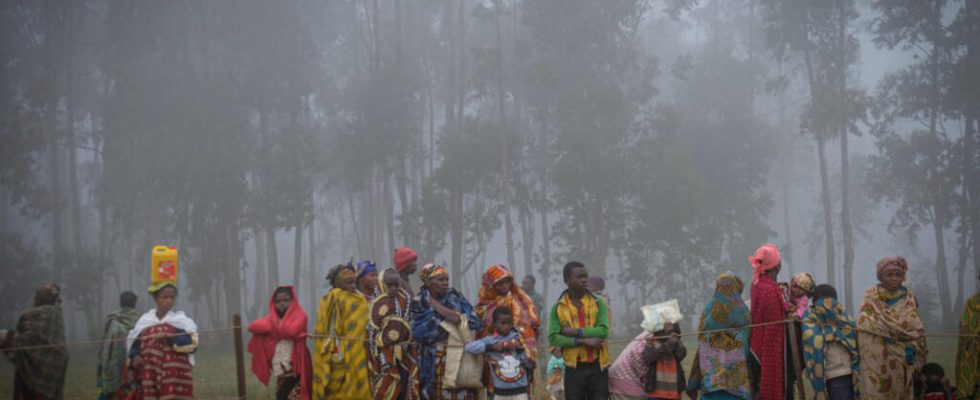Through the work of Congolese and South African photographers, the Bayeux War Correspondents Prize traces in an exhibition three decades of violence in the regions of Ituri, North and South Kivu.
5 mins
The Bayeux Prize chose to entrust Maria Malagardis, journalist at Release, the difficult task of summarizing in an exhibition 30 years of bloody conflicts in eastern DRC. Very quickly, something became obvious to the senior reporter, who covers the Great Lakes region for the French daily: “ We wanted to tell the conflict from an African point of view, she explains. The photos were all taken by photojournalists from the continent – South African Guy Tillim – and four Congolese photographers – Moses Sawasawa, Esther N’sapu, Ley Uwera and Dieudonné Dirole “.
Built thematically and not chronologically, the exhibition brings together around fifty photos and deals with the issue of armed groups, movements of displaced people, sexual violence, child labor in cobalt mines, but also of daily life, in this region which has more than 95 million inhabitants. “ It is a crisis that is often reduced to clashes between rebel groups and regular armies or to UN forces. This is the central problem, of course, but it is not the only one », explains the big reporter.
The organizers chose to title the exhibition “ The other side of paradise “. “ We wanted to show that in what can appear to be a hell of violence and fear, the citizens of this region still continue to maintain hope and develop resistance strategies, whether through the arts, festivals… », explains Maria Malagardis. With this work, she wishes to address Western visitors, who sometimes know very little about eastern DRC, “ These people who live so far from us ultimately have the same aspirations: to live happily, have children, love each other, earn money, succeed in life. »
scope.counterText
scope.legend
scope.counterText
scope.legend
© scope.credits
“ Despite everything that happens, people continue to live »
Documenting the life that continues despite the war is also what photojournalist Ley Uwera, who traveled from Goma, is trying to do. She tells us the story of one of her photos, taken in Beni in North Kivu, in 2016. “ I had just arrived in the city, an area very affected by insecurity, to cover the massacre of numerous civilians, killed the day before. Suddenly I saw these bridesmaids on the motorcycle. I wanted to take photos of them to show this contrast between the massacre and the wedding that was taking place. It’s an area that many think is unlivable, but despite everything that happens there, people continue to live. »
Ley Uwera, like his colleague Esther N’sapu, grew up with the war. The young thirty-somethings regularly go out into the field together. “ Working as a woman and a freelancer is not easy. People are not used to seeing women photographers, explains Esther N’Sapu. You are called everything: prostitutes, worthless women, someone bought by white people. (…) In the countryside, when people see the camera, they run away from you. » « It’s often difficult to convince people to have their photo taken, confirms Ley Uwera. Sometimes we are asked for money. I always go to them to explain my approach and ask them for permission to take photos of them. If they refuse, I give up “. The two photographers sometimes work with humanitarian organizations and often go into the field with security teams.
“ Reality is hidden for one simple reason: it’s too dangerous to go there »
Because working conditions are increasingly complicated and dangerous for journalists. Showing us a photo taken in the Masisi massif, in North Kivu, Esther N’Sapu explains: “ Renowned for its production of milk and cheese which is consumed in many Congolese towns, this region is also coveted by armed groups and self-defense groups, because of the Rubaya mine. I reported there in 2019, when the region was still a little calm. Today, it is very difficult to access it because of the presence of the M23. »
“ Finally, if you look at this exhibition, you will see that there are very few photos of deaths and massacres, Maria Malagardis points out to us. On the first floor, there are photos of mutilated children, which are quite violent, but which do not tell the truth. The reality is obscured, it is hidden and for one simple reason: it is too dangerous to go there. », Explains the senior reporter, who receives daily photos and videos from residents of the region. “ When you are a journalist, there is a rather dizzying dimension of a conflict relayed on WhatsApp groups by videos and photos of ordinary citizens, while journalists themselves are prevented from doing so, even in Goma. ”, she laments.
The collective exhibition 30 years of war in the East of the Democratic Republic of Congo: “The other side of paradise” is on view in Bayeux, until November 12, 2023.
